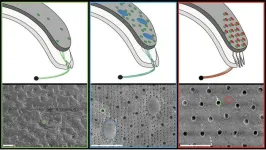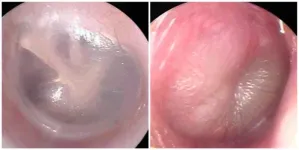(Press-News.org) Switzerland plans to reduce its net carbon emissions to zero by no later than 2050. To achieve this, it will need to drastically reduce its greenhouse gas emissions. In its climate strategy, the Swiss government acknowledges that some of these emissions, particularly in agriculture and industry, are difficult or impossible to avoid. Swiss climate policy therefore envisages actively removing 5 million tonnes of CO2 from the air and permanently storing it underground. By way of comparison, the Intergovernmental Panel on Climate Change (IPCC) estimates that up to 13 billion tonnes of CO2 will need to be removed from the atmosphere every year from 2050.
These targets will be hard to achieve unless ways can be found to reduce the cost of direct air capture (DAC) technologies. ETH spin-off Climeworks operates a plant in Iceland that currently captures 4,000 tonnes of CO2 a year, at a cost per tonne of between 1,000 and 1,300 dollars. But how quickly can these costs come down as deployment increases?
ETH researchers have developed a new method that provides a more accurate estimate of the future cost of various DAC technologies. As the technologies are scaled up, direct air capture will become significantly cheaper – though not as cheap as some stakeholders currently anticipate. Rather than the oft-cited figure of 100 to 300 US dollars, the researchers suggest the costs are more likely to be between 230 and 540 dollars.
“Just because DAC technologies are available, it certainly doesn’t mean we can relax our efforts to cut carbon emissions. That said, it’s still important to press ahead with the expansion of DAC plants, because we will need these technologies for emissions that are difficult or impossible to avoid,” says Bjarne Steffen, ETH Professor of Climate Finance and Policy. He developed the new method together with Katrin Sievert, a doctoral student in his research group, and ETH Professor Tobias Schmidt.
Three technologies and their costs
The ETH researchers applied their method to three direct air capture technologies. The goal was to compare how the cost of each technology is likely to evolve over time. Their findings suggest that the process developed by Swiss company Climeworks, in which a solid filter with a large surface area traps CO2 particles, could cost between 280 and 580 US dollars per tonne by 2050.
The estimated costs of the other two DAC technologies fall within a similar range. The researchers calculated a price of between 230 and 540 dollars a tonne for the capture of CO2 from the atmosphere using an aqueous solution of potassium hydroxide, a process that has been commercialised, for example, by Canadian company Carbon Engineering. The cost of carbon capture using calcium oxide derived from limestone was estimated at between 230 and 835 dollars. This latter method is offered by US company Heirloom Carbon Technologies, among others.
Focus on components
Estimating how the cost of new technologies will change over time is particularly difficult in situations where very little empirical information is available. This lack of real-world data represents a challenge for DAC technologies: they haven’t been in use long enough to allow projections to be made as to how their cost might evolve in the future. To address this dilemma, the ETH researchers focused on the individual components of the different DAC systems and estimated their cost one by one. They then asked 30 industry experts to assess the design complexity of each technological component and determine how easy it would be to standardise.
The researchers based their work on certain assumptions: namely, that the cost of less complex components that can be mass-produced will fall more sharply, while the cost of complex parts that must be tailored to each individual system will fall only slowly. DAC systems also include mature components such as compressors, which cannot feasibly be made much cheaper. Once the researchers had estimated the cost of each individual part, they then added the cost of integrating all the components and the costs of energy and operation.
Despite significant uncertainties in their calculations, the researchers’ message was clear: “At present, it is not possible to predict which of the available technologies will prevail. It is therefore crucial that we continue to pursue all the options,” says Katrin Sievert, lead author of the study, which recently appeared in the journal Joule.
END
Cost of direct air carbon capture to remain higher than hoped
2024-03-04
ELSE PRESS RELEASES FROM THIS DATE:
Unraveling the mystery of chiton visual systems
2024-03-04
(Santa Barbara, Calif.) — You’d probably walk past a chiton without even seeing it. These creatures often look like nothing more than another speck of seaweed on the crusty intertidal rocks. But it sees you. At least, if it’s one of the species with eyes dotting its platemail shell.
A team of scientists — led by Rebecca Varney at UC Santa Barbara’s Department of Ecology, Evolution, and Marine Biology (EEMB) — discovered that some of these tough mollusks sport the most recently evolved eyes with a lens. What’s more, the ...
Case Western Reserve University-led research team discovers new method to test for oral cancer
2024-03-04
CLEVELAND—Oral cancers and precancerous mouth lesions are considered especially difficult to diagnose early and accurately.
For one, biopsies are expensive, invasive, stressful for the patient and can lead to complications. They’re also not feasible if repeated screenings of the same lesion are required.
But a team of researchers, led by a clinician scientist at the Case Western Reserve University School of Dental Medicine, has discovered a noninvasive, low-cost test to detect oral cancer, monitor precancerous lesions and determine when a biopsy is warranted.
Their findings, published ...
Firearm access and gun violence exposure are common in Black and native communities
2024-03-04
A New Jersey Gun Violence Research Center study is the first to provide nationally representative data on gun use, storage and violence within Black and American Indian/Alaskan Native (AIAN) families.
Both Black and native communities have seen increasingly elevated rates of gun violence victimization, including homicide and suicide, according to the Centers for Disease Control and Prevention. In recent years, minorities have become more represented among new firearm owners. Despite this, research on firearm access, storage and use has focused on samples of white adults. This prevents understanding the access Black and native individuals have to firearms, whether they are stored ...
New AI smartphone tool accurately diagnoses ear infections
2024-03-04
A new cellphone app developed by physician-scientists at UPMC and the University of Pittsburgh, which uses artificial intelligence (AI) to accurately diagnose ear infections, or acute otitis media (AOM), could help decrease unnecessary antibiotic use in young children, according to new research published today in JAMA Pediatrics.
AOM is one of the most common childhood infections for which antibiotics are prescribed but can be difficult to discern from other ear conditions without intensive training. The new AI tool, which makes a diagnosis by assessing ...
Screen time and parent-child talk when children are ages 12 to 36 months
2024-03-04
About The Study: This study found a negative association between screen time and measures of parent-child talk when children are 12 to 36 months of age. For every additional minute of screen time, children heard fewer adult words, spoke fewer vocalizations, and engaged in fewer back-and-forth interactions. Interventions aiming to promote early use of language should include support to manage screen time.
Authors: Mary E. Brushe, Ph.D., of the University of Western Australia in Adelaide, South Australia, Australia, is the corresponding author.
To access the embargoed study: Visit our For The Media website at this link https://media.jamanetwork.com/
(doi:10.1001/jamapediatrics.2023.6790)
Editor’s ...
Firearm access and gun violence exposure among American Indian or Alaska native and Black adults
2024-03-04
About The Study: In this nationally representative survey study of 3,542 American Indian or Alaska Native and Black U.S. adults, a substantial percentage of both groups reported living in homes with firearms, storing firearms loaded and unlocked, frequently carrying firearms outside the home, and having been exposed directly and indirectly to gun violence. These findings underscore the need for nuanced public health campaigns and policies and highlight challenges for law enforcement in contexts of racial disparities ...
Associations of medical debt with health status, premature death, and mortality in the US
2024-03-04
About The Study: The findings of this study of 2,943 counties suggest that medical debt is associated with worse health status, more premature deaths, and higher mortality rates at the county level in the U.S. Therefore, policies increasing access to affordable health care, such as expanding health insurance coverage, may improve population health.
Authors: Xuesong Han, Ph.D., of the American Cancer Society in Atlanta, is the corresponding author.
To access the embargoed ...
Low-cost liquid tames tooth decay
2024-03-04
An inexpensive, cavity-fighting liquid called silver diamine fluoride (SDF) works as well as dental sealants to keep tooth decay at bay in a school cavity prevention and treatment program, according to a new study by researchers at NYU College of Dentistry.
The study, which followed more than 4,000 elementary school students for four years and is published in JAMA Pediatrics, shows that SDF is an effective alternative to sealants, and can increase access to dental care while reducing costs.
Dental cavities are the most prevalent ...
More than 1/3 illicit drugs sold on the dark web contain unexpected substances
2024-03-04
Testing of illicit drugs bought online found 35% were not what they said they were, highlighting the urgent need for more local drug testing facilities in Australia to prevent harm and overdose.
The RMIT-led study analysed 103 illicit drug samples sourced from the now-defunct dark web forum Test4Pay in collaboration with the Australian National University, UNSW Sydney and Canadian testing facility Get Your Drugs Tested.
While 65% of samples contained only the advertised substance, the study found 14% of samples had a mixture ...
A better way to deliver fetal therapy for serious genetic disorders
2024-03-04
In a discovery that opens the door to a less invasive way of treating some serious disorders before birth, UC San Francisco scientists have found that delivering medicine through amniotic fluid is as effective as delivering it to the fetal brain via cerebrospinal fluid. The experiment was done in mice with a genetic disorder called Angelman syndrome.
Treating genetic diseases like Angelman in utero could prevent serious symptoms that begin while the fetus is still developing. It’s also easier to access neurons in the fetal brain because the blood-brain barrier that normally acts as a filter ...



